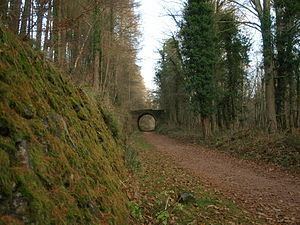Dates of operation 1810–1977 | ||
 | ||
Track gauge 1,435 mm (4 ft 8 ⁄2 in) Previous gauge 7 ft ⁄4 in (2,140 mm)from 1868 to 18723 ft 6 in (1,067 mm) before 1868 | ||
The Severn and Wye Railway was a small rail and canal network in west Gloucestershire, initially constructed to allow exploitation of the mineral resources of the Forest of Dean. In 1810, The Severn and Wye Railway and Canal Company began construction of a tramway and the Lydney Canal. In 1868 a 7 ft 1⁄4 in (2,140 mm) broad gauge railway was added, to run alongside the existing tramway, but work began to replace both with standard gauge tracks in 1872. After bankruptcy in 1885 the line was purchased jointly by the Midland Railway and the Great Western Railway. At its largest extent the railway consisted of 39 miles (63 km) of track. Lydney Canal was opened in 1813 and closed in 1977, but has since been restored and reopened.
Contents
History
The Severn and Wye Railway was authorized by parliament in 1809 as the Lydney & Lydbrook Railway. It changed its title to the Severn and Wye Railway and Canal Company in the following year and work began on the construction of a tramway and the Lydney Canal. The line was opened in June 1810 and ran from Lydney to Lydbrook via Mierystock Junction (near Serridge Platform), from where there was a branch to Churchway, as a 3 ft 6 in (1,067 mm) gauge tramroad operated by horses. In 1864 a 0-4-0 well tank locomotive was purchased by the company with flangeless wheels for use on the plateway. Proving successful, four more plateway locomotives were delivered in 1865.
In 1868 a broad gauge line was laid alongside the existing tramroad from Lydney (GWR) to Wimberry, one of the plateway locomotives altered to 7 ft (2,134 mm) gauge and a new broad gauge convertible locomotive delivered, however due to a land dispute with the Crown Commissioners that line was not opened until the following year, when two more plateway locomotives were altered for use on it. In 1870 a further broad gauge convertible locomotive was delivered, but between 1872 and 1874 both the broad gauge track and tramway were re-laid to standard gauge, after the GWR converted its South Wales line through Lydney. The Mineral Loop was opened in 1872 and a branch to Coleford from Parkend opened in 1875. The first passenger train ran on 23 September 1875 between Lydney and Lydbrook. When the Severn Railway Bridge opened in 1879, the Severn Bridge Railway was amalgamated with the Severn and Wye Railway, becoming the Severn and Wye and Severn Bridge Railway. On amalgamation on the bridge opening day, 17 October 1879, the S&W&SBC had capital of £415,400. The 1885 scheme of arrangement sold it to the GWR and MR for £477,300.
Following bankruptcy in 1885 the line was purchased jointly by the Midland Railway and the Great Western Railway, officially becoming a joint venture on 1 July 1894 and known as the Severn and Wye Joint Railway (S&WJR). An extension to Cinderford was opened in 1900.
The 'Main Line' ran from Sharpness on the southeastern bank of the River Severn across the river via the Severn Railway Bridge to Lydney on the northwestern bank and then on to Cinderford. Here trains reversed to continue to Lydbrook Junction on the GWR line from Ross-on-Wye to Monmouth (the Ross and Monmouth Railway). There were many branches to various collieries and a 'Mineral Loop' line was built to avoid reversal at Cinderford and the steep gradient from Speech House Road to Serridge Junction. A short branch to Coleford, which had a small station at Milkwall was opened and it connected with the Coleford Railway and Wye Valley Railway. At one point passengers could then catch a train on to Monmouth station. When the Coleford Railway closed in 1917 the railway took over the short stretch to Whitecliff Quarry. The quarry closed in 1976. Apart from the bridge over the Severn, the only major engineering features were a tunnel at Mierystock and Lower Lydbrook Viaduct (now demolished).
Regular passenger services north of Lydney Town stopped in 1929; however, the Berkeley Road - Lydney Town service was only halted by the collapse of the Severn Railway Bridge in 1960. Freight services on the line lasted much longer than passenger; the Lydbrook arm closed completely in 1956, (the line had been near dormant for several years before), the branch to Coleford and Whitecliff Quarry closed in 1967 and the section to Parkend finally closed in 1976.
Current usage
The stretch between Parkend and Lydney is now restored and open as the heritage Dean Forest Railway, whose long term objective is to extend a further 2.5 miles (4.0 km) to Speech House Road.
Many of the other parts of the route have been converted into cycleways. The Sharpness Branch Line is still open to serve the surviving industry in Sharpness Docks. The goods shed at Coleford Station (S&WR) has now been turned into a museum highlighting the activities of the Great Western Railway.
